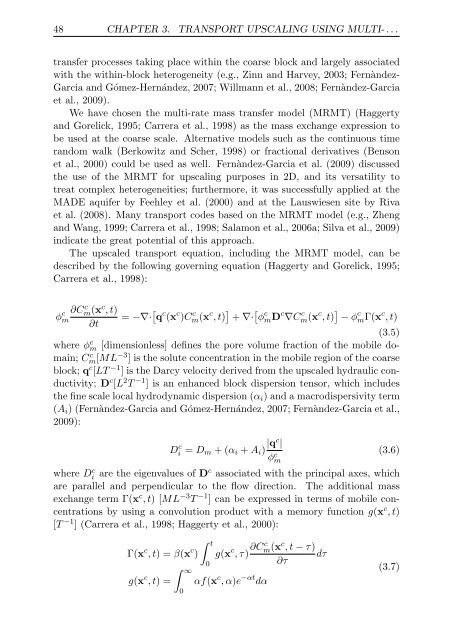Upscaling and Inverse Modeling of Groundwater Flow and Mass ...
Upscaling and Inverse Modeling of Groundwater Flow and Mass ...
Upscaling and Inverse Modeling of Groundwater Flow and Mass ...
You also want an ePaper? Increase the reach of your titles
YUMPU automatically turns print PDFs into web optimized ePapers that Google loves.
48 CHAPTER 3. TRANSPORT UPSCALING USING MULTI- . . .<br />
transfer processes taking place within the coarse block <strong>and</strong> largely associated<br />
with the within-block heterogeneity (e.g., Zinn <strong>and</strong> Harvey, 2003; Fernàndez-<br />
Garcia <strong>and</strong> Gómez-Hernández, 2007; Willmann et al., 2008; Fernàndez-Garcia<br />
et al., 2009).<br />
We have chosen the multi-rate mass transfer model (MRMT) (Haggerty<br />
<strong>and</strong> Gorelick, 1995; Carrera et al., 1998) as the mass exchange expression to<br />
be used at the coarse scale. Alternative models such as the continuous time<br />
r<strong>and</strong>om walk (Berkowitz <strong>and</strong> Scher, 1998) or fractional derivatives (Benson<br />
et al., 2000) could be used as well. Fernàndez-Garcia et al. (2009) discussed<br />
the use <strong>of</strong> the MRMT for upscaling purposes in 2D, <strong>and</strong> its versatility to<br />
treat complex heterogeneities; furthermore, it was successfully applied at the<br />
MADE aquifer by Feehley et al. (2000) <strong>and</strong> at the Lauswiesen site by Riva<br />
et al. (2008). Many transport codes based on the MRMT model (e.g., Zheng<br />
<strong>and</strong> Wang, 1999; Carrera et al., 1998; Salamon et al., 2006a; Silva et al., 2009)<br />
indicate the great potential <strong>of</strong> this approach.<br />
The upscaled transport equation, including the MRMT model, can be<br />
described by the following governing equation (Haggerty <strong>and</strong> Gorelick, 1995;<br />
Carrera et al., 1998):<br />
ϕ c ∂C<br />
m<br />
c m(xc , t)<br />
= −∇·<br />
∂t<br />
[ q c (x c )C c m(x c , t) ] + ∇· [ ϕ c mD c ∇C c m(x c , t) ] − ϕ c mΓ(x c , t)<br />
(3.5)<br />
where ϕc m [dimensionless] defines the pore volume fraction <strong>of</strong> the mobile domain;<br />
Cc m[ML−3 ] is the solute concentration in the mobile region <strong>of</strong> the coarse<br />
block; qc [LT −1 ] is the Darcy velocity derived from the upscaled hydraulic conductivity;<br />
Dc [L2T −1 ] is an enhanced block dispersion tensor, which includes<br />
the fine scale local hydrodynamic dispersion (αi) <strong>and</strong> a macrodispersivity term<br />
(Ai) (Fernàndez-Garcia <strong>and</strong> Gómez-Hernández, 2007; Fernàndez-Garcia et al.,<br />
2009):<br />
D c i = Dm + (αi + Ai) |qc |<br />
ϕc (3.6)<br />
m<br />
where Dc i are the eigenvalues <strong>of</strong> Dc associated with the principal axes, which<br />
are parallel <strong>and</strong> perpendicular to the flow direction. The additional mass<br />
exchange term Γ(xc , t) [ML−3T −1 ] can be expressed in terms <strong>of</strong> mobile concentrations<br />
by using a convolution product with a memory function g(xc , t)<br />
[T −1 ] (Carrera et al., 1998; Haggerty et al., 2000):<br />
Γ(x c , t) = β(x c ∫ t<br />
)<br />
0<br />
g(x c ∫ ∞<br />
, t) =<br />
0<br />
g(x c , τ) ∂Cc m(xc , t − τ)<br />
dτ<br />
∂τ<br />
αf(x c , α)e −αt dα<br />
(3.7)


